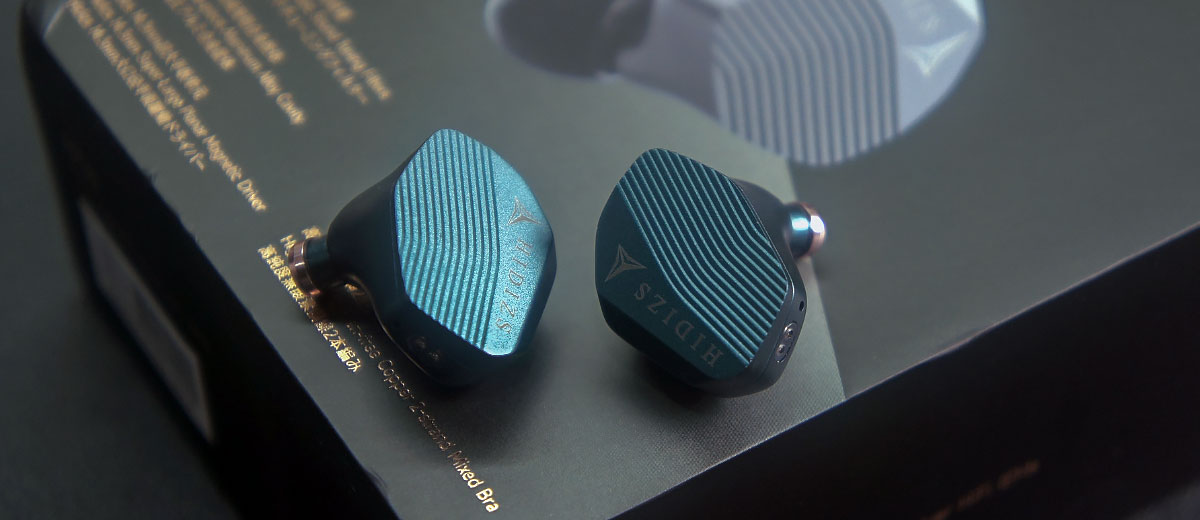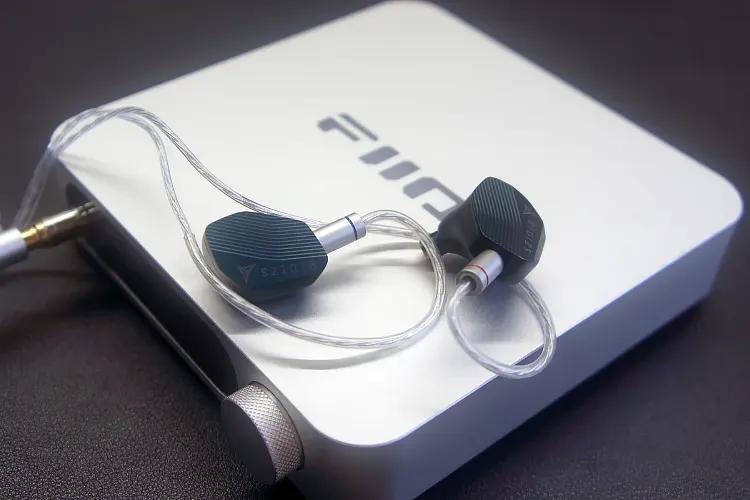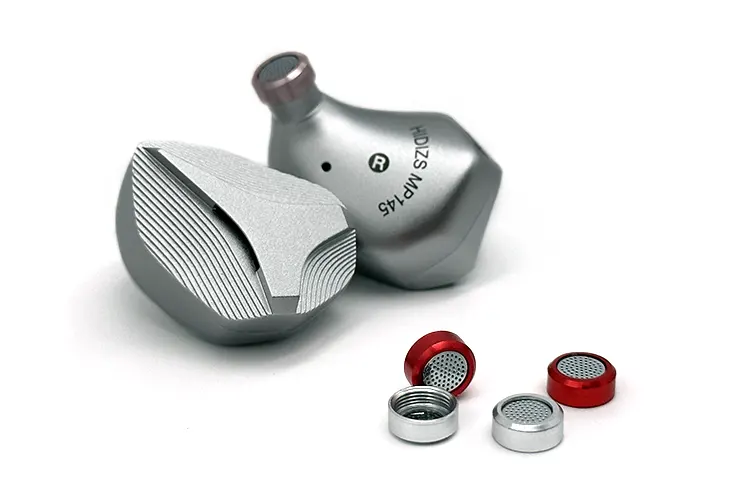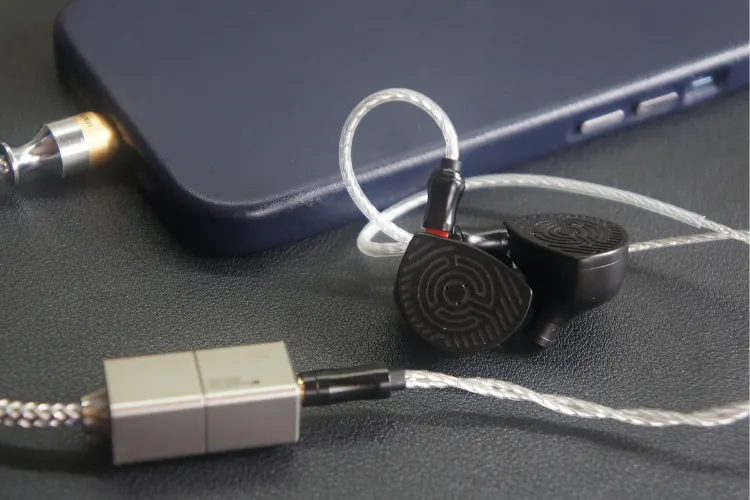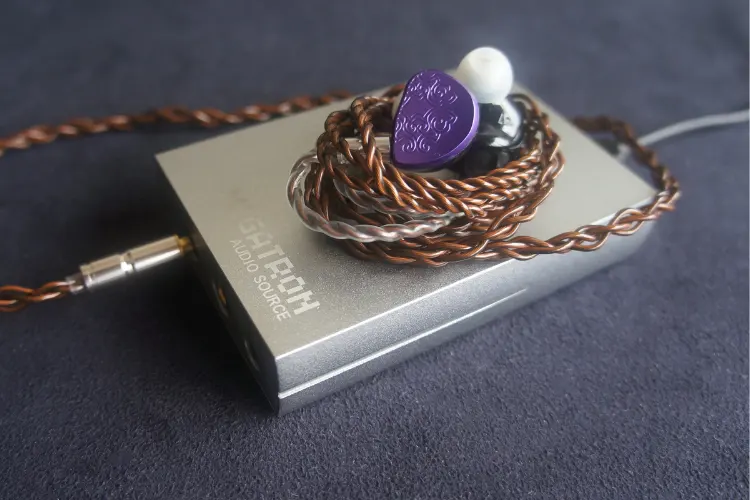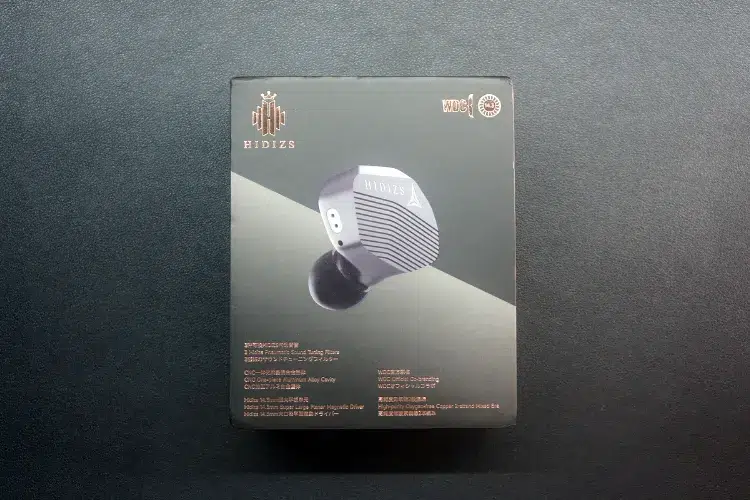Synergy
Efficiency
The MP143 Salt has an impedance of 17Ω and a sensitivity of 103 dB/mW, making it compatible with laptops, tablets, DAPs, and smartphones. However, its resolution benefits from a more powerful amplifier or powerful dongle DAC.
During my on-the-go testing with the MP143 Salt, I paired it with the ddHiFi TC35Pro E2 and 7Hz SEVENHERTZ 71 dongle DACs. For desktop use, I connected it to the FiiO K11 desktop DAC/AMP via its 6.35mm SE output.
While I achieved full extension and dynamics through the dongle DACs, I observed slightly better resolution performance when I paired the MP143 Salt with the FiiO K11.
Pairings
The MP143 Salt pairs well with DACs/ Dongles that have a warmer presentation. Throughout my testing, I preferred pairing it with the 7Hz SEVENHERTZ 71 and the FiiO K11.
I found that the low-end warmth added by the 7Hz 71 gave instruments on the lower mid-range a more bodied presentation. This evened out the overall tonality of the MP143 Salt while maintaining its technically impressive resolution and imaging performance.
Given the minimal resolution improvement I observed, I still prefer pairings with dongles and see the minor resolution hit as a fair tradeoff for the increased convenience.
Select Comparisons
Hidizs MP145
Technical
Both the Hidizs MP145 and MP143 Salt use a single planar magnetic driver. However, the MP145 opts for a slightly larger 14.5mm driver compared to the MP143 Salt’s 14.3mm planar magnetic driver.
The MP145 has an impedance and sensitivity of 30Ω and 104 dB, while the MP143 Salt has an impedance of 17Ω and a slightly higher sensitivity of 103 dB. In practice, I found that the MP145 is harder to drive.
Design
Coming from the same brand and sharing the same design philosophy, both IEMs have CNC-machined aluminum bodies with an anodized finish. The fit and finish of both IEMs are almost identical, however, the main difference lies in their shapes
The MP145 uses a larger shell with a more intricate faceplate. The faceplate is cut by 3 strong edges, forming a fin towards the center of the shell. The MP143 Salt’s shell is shallower and comes off as an accent to the shape.
For day-to-day use, I found the MP143 Salt’s smaller and lighter shell more comfortable. The isolation performance was almost identical between both IEMs, but I found the MP143 Salt better at maintaining a seal throughout my on-the-go usage.
Performance
The MP143 Salt has a brighter sound, with an emphasis on treble clarity and detailed mids, the bass is more restrained, providing a more analytical listening experience.
The MP143 Salt boosts its microdetail retrieval and imaging properties, giving it an almost artificially detailed tonality. Treble and mid-range instruments on the MP143 Salt have better resolution and better imaging, but its metallic timber can make it less enjoyable in comparison
The MP145 features a warmer, more balanced sound profile with a strong emphasis on bass and mids, delivering a fuller and richer sound.
Basslines and kick drums have a more impactful and exciting tonality to them through the MP145, with string instruments in the mid-range having superior note weight and dynamics as well.
The MP145 has a more relaxing sound signature that excels in providing a large sound stage that gives up some imaging and resolution performance for a more engaging and enjoyable listening experience.
Shozy P20
Technical
The Hidizs MP143 Salt and the Shozy P20 use a single planar magnetic driver, with the P20 using a larger 14.5mm planar magnetic driver compared to the Salt’s 14.3mm driver.
The MP143 Salt has an impedance and sensitivity of 17Ω and 103 dB, while the Shozy P20 has an impedance of 30Ω and a slightly higher sensitivity of 105 dB. In practice, both IEMs were quite similar in terms of drivability.
Design
The Hidizs MP143 Salt’s shell is constructed from CNC-machined aluminum with a whale baleen plate-design aesthetic. The ridges and anodized paint finish of the MP143 Salt make it visually stand out, especially when the light hits and exaggerates the contours of each faceplate ridge.
In contrast, the P20 also uses a full aluminum shell, however, its faceplate designs are less 3 dimensional, instead opting for a simple circular pattern on a brushed aluminum panel. This is in contrast to the anodized aluminum finish used in the MP143 Salt.
In day-to-day usage, I found that the P20 was observably more comfortable than the MP143 Salt due to its lighter construction, and more ergonomic shape fitting my ear better.
Performance
The P20 outshines the Hidizs MP143 Salt with a more pronounced low-end punch. The P20 delivers a warmer sound signature, adding more body to vocals and providing a richer overall tone.
However, this warmth comes with a trade-off: the P20’s mid-bass can bleed into the mids, creating a slight bloat that affects overall clarity. The P20’s bass profile leans towards a V-shaped signature with a noticeable low-end hump, making it a good fit for those who prefer a bass-heavy, warm sound.
In the midrange, the MP143 Salt excels in vocal resolution, offering a cleaner and more detailed presentation. However, the P20 counters with vocals that, while less resolved, carry more emotion and an organic quality that some listeners might find more engaging.
The P20’s mids have a natural warmth that adds a layer of richness to the sound, whereas the MP143 Salt provides a more analytical and precise vocal delivery.
The treble performance of the MP143 Salt is where it truly stands out. It offers better resolution, highlighting high-frequency details like cymbals and chimes that can be lost in the P20’s warmer mix.
The MP143 Salt’s treble is more accurate and neutral, avoiding the sibilance that the P20 can sometimes exhibit.
On the other hand, the P20 can lean towards sibilance, making it less ideal for those sensitive to sharper highs. The MP143 Salt’s treble, with its balanced detail, offers a more refined listening experience.
The P20 has a wider sound stage, which can make it seem less congested in complex tracks. However, the MP143 Salt compensates with superior imaging performance, allowing for more precise placement of instruments within the soundstage.
While the P20 offers a broader sense of space, the MP143 Salt’s ability to accurately position sounds gives it an edge in terms of overall clarity and detail.
Tangzu Zetian Wu
Technical
Both IEMs use a single planar magnetic driver, with the MP143 Salt opting for a smaller 14.3mm FAST 2 driver compared to the Tangzu‘s 14.5mm driver.
The MP143 Salt has an impedance and sensitivity of 17Ω and 103 dB, while the Zetian Wu has a lower impedance of 16Ω and a lower sensitivity of 100 dB @1kHz.
Design
The Zetian Wu features a shell made from 3D-printed, semi-translucent resin with a sleek dark glossy finish. It’s complemented by a distinct metal faceplate, finished in brushed purple, adorned with oriental-inspired engravings that add an elegant touch to each side.
The Hidizs MP143 Salt’s shell is crafted from CNC-machined aluminum, featuring a whale baleen-inspired plate design. Its ridges, combined with an anodized paint finish, create a striking visual effect, particularly when light accentuates the contours of each faceplate.
Performance
These two IEMs have different bass presentations. The MP143 Salt leans towards a slightly more pronounced mid-bass, delivering a solid rumble that spreads throughout the track.
However, the Zetian Wu excels in sub-bass performance, offering a deeper and more impactful low end that gives bass-heavy tracks a satisfying rumble. The Zetian Wu’s overall warmth also makes its bass more enjoyable and engaging, especially for those who prefer a richer, fuller sound.
The Zetian Wu delivers a more dynamic and engaging midrange, particularly with instruments, offering a sound that is warm and relaxing.
The MP143 Salt provides a more detailed but cooler presentation. It has more precision and clarity in the mids, whereas the Zetian Wu focuses on a more soothing and enjoyable listening experience, making it feel almost like the polar opposite of the MP143 Salt’s more analytical nature.
The MP143 Salt outshines the Zetian Wu in terms of treble resolution and texture. The MP143 Salt’s treble is more detailed and refined, allowing for greater clarity in the upper frequencies.
The Zetian Wu compensates with a more dynamic and impactful treble, which, although lacking the same level of microdetail, provides a lively and energetic listening experience that some may find more appealing
The soundstage of the Zetian Wu is noticeably wider, creating a more expansive listening environment. Despite this, the MP143 Salt excels in imaging, offering superior microdetail and precision in placing instruments within the soundstage.
The Zetian Wu, while still capable of good detail resolution typical of planar drivers, doesn’t quite match the MP143 in delivering the same level of fine detail.
However, its wider soundstage and more relaxed presentation make it an enjoyable choice for those who prioritize space and ambiance in their music.
My Verdict
With its blend of good technicalities and tuning flexibility through its replaceable tuning nozzles, audiophiles looking to pick up their first Planar IEM may want to consider the Hidizs MP143 Salt to experience a competitive Planar IEM performance with an affordable price tag.
With good vocal clarity and treble resolution, alongside a surprising amount of mid-bass, it may be a demo-worthy choice for audiophiles who enjoy critical listening of jazz and classical music.
Hidizs MP143 Salt Technical Specifications
- Driver configuration: 14.3mm Planar Magnetic Driver
- Frequency response: 20 Hz – 40 kHz
- Impedance: 17 Ω
- Sensitivity: 103 dB
- Connector: 0.78mm 2-pin
- Plug: 3.5mm

